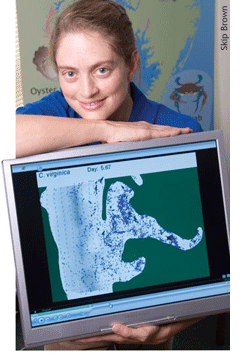Thrive Again?
Confront
the Bay's
Complexity
Photograph: Oyster reproduction begins with a spawning oyster, like this native one, releasing a cloud containing millions of eggs. Photograph by Mike Reber.
Contents
By Erica Goldman

On a warm June day beneath the waters of the Choptank River on Maryland's Eastern Shore, oysters on one of the river's last remaining reefs begin to spawn. The male's shell parts slightly and a white thread of sperm issues forth from the gap in a steady stream. Nearby, a female oyster raises her shell and brings it down with a sudden clap, a pulse of whitish eggs puffing out. She claps again. Pretty soon, neighboring oysters join in, clapping their shells in unison, turning the water milky white with maybe billions of eggs and sperm. A single female may release as many as 25 million eggs during a single spawn.
When the clapping subsides, the clouds disperse. The now-fertilized eggs divide again and again. Soon they sprout hairlike cilia and begin a microscopic journey. If the larvae survive tides, currents, let alone a score of predators, they will change shape and begin to make active decisions about where to swim. After two weeks, these tiny animals will begin to scout out an oyster reef on which to attach permanently and transform into adults.
How far will the larvae travel? How many will find an oyster bar on which to settle and begin adult life? How many will die before reaching one? With millions of larvae no larger than a pencil dot, answers to these questions lie beyond the reach of the human eye.
So how can one follow larvae on this unseen journey, a task critical to predict whether oyster populations can once again thrive in the Chesapeake Bay? Mathematical models may be able to take over where the eye leaves off, translating years of laboratory and field observations into equations that account for the major forces at work — currents, tides, and larval behavior.
With a few deft keystrokes, scientist Elizabeth North calls up a schematic map of the Choptank River on her computer screen — now she fills it with clouds of blue dots, simulated oyster larvae spread throughout the river. Small irregular shapes on the map represent oyster reefs, settlement targets where larvae will begin life as adults.
North's fingers play over the keyboard and the virtual larvae lurch into motion. Blue dots slosh back and forth on the screen, subject as they are to forces that numerically mimic the tides. The clock at the top of the screen ticks forward rapidly — six hour tidal cycles advance in a matter of seconds. . .Day 1. . .Day 2. . . Still the blue dots slosh back and forth in this computerized Choptank. . .Day 9. . . Day 10. On Day 14, some dots suddenly turn green and stop moving. The larvae are now mature enough to settle if they encounter suitable habitat. The pressure is on. The larvae's genetic code dictates that after they become competent to settle — a life stage called pediveliger — they must find substrate within another 7 days. If they fail to find a place, they cannot metamorphose. They will die.
By Day 21, the sloshing stops. The larvae have met their fate. On North's screen, larvae that have successfully settled stay green, while the dead oyster larvae turn orange, rendering the virtual Choptank a patchwork of color.
This "settle or die" oyster drama will play out over and over again on her computer as North, a biologist and mathematical modeler, runs model simulation after simulation. From her quiet, uncluttered office on the shores of the real Choptank River, at the University of Maryland Center for Environmental Science (UMCES) Horn Point Laboratory (HPL), North first gives the blue dots the behavioral traits of the native oyster, Crassostrea virginica, derived from published data accumulated over years of scientific study and recent laboratory experiments. Then she will run the same scenarios again with the behaviors of the non-native Asian oyster, Crassostrea ariakensis.
As though comparing the performance of two cars, North's model serves as a tool to test drive the two species of oyster, projecting whether one species can reach the finish line (i.e., settlement on an oyster reef) more successfully than the other. Her work will help show which species might better repopulate the Chesapeake with sustainable oyster populations. During the half century from 1920-1970, oyster populations held steady while supporting a profitable — and sustainable — fishery for watermen and oyster farmers. A return to such levels is currently held as a restoration target for an ongoing Environmental Impact Statement (see Assessing a Potential Introduction).
North's steady presence in front of the flat computer screen reveals no hint of the contentious nature of the debate that swirls at the heart of her work. The outcomes of North's model — maps that predict where larvae of the two oyster species will settle — will likely play an important role in the decision about whether to introduce the fast-growing, non-native Asian oyster to Chesapeake Bay. On one hand, the Bay's oyster industry hangs by a thread — Maryland's harvests alone have declined by more than 90 percent from 1970s levels. Each year more watermen abandon their heritage for more economically sustainable work, while only a handful of shucking houses remain. Equally important, the filtering prowess of oyster populations could help reverse seasonal oxygen depletion and turbid waters, helping to renovate the Bay's damaged ecology. Many have argued that the Asian oyster might have the capability to do just that.
But a decision to introduce the Asian oyster may be a risky one. This species could not only invade areas outside of the Chesapeake Bay, it could also bring new shellfish diseases to the region. In addition, the Asian oyster could outcompete the native oyster for already-diminished reef habitat, which might deal a final deathblow to its restoration. Furthermore, there are no guarantees that such an introduction will even work to bring oysters back to the Bay or clear up its murky waters. Much of its promise is based on preliminary research and extrapolation from studies of its biology in other regions. North's computer simulations, which compare the settlement patterns of the native and non-native species, will help provide some of the first predictions of the potential for sustainable oyster populations in the Chesapeake Bay.
North works in the midst of this controversial spotlight. She recognizes that her research will provide tools to environmental managers directly, a rare and exciting opportunity to serve as a bridge between science and policy. But the glare can be intense. With policy makers in Maryland and Virginia awaiting the results of research from her and other oyster scientists in the region, she works rigorously and as quickly as possible. Her project is one of 12 funded by the Maryland Department of Natural Resources to address urgent scientific questions about the non-native oyster to help assess potential risks posed by an introduction. And whatever the final decision by the states about whether to introduce the Asian oyster to the Chesapeake Bay, North knows that the outcome of her modeling efforts could someday land at the center of a controversial debate.
Master of a virtual Choptank River, Elizabeth North turns hours into seconds and days into minutes, tracking the ebb and flow of oyster larvae as they search for a place to settle. North's models form part of an elaborate process aimed at predicting the survival of both native and non-native oysters in the Chesapeake. Photograph by Skip Brown.

As a young researcher, North is grateful for collaborations with colleagues Raleigh Hood, Ming Li, and Liejun Zhong of HPL, and Tom Gross of the National Oceanic and Atmospheric Administration & Chesapeake Research Consortium, and she welcomes the tough scrutiny of academic peer review every step along the way. Peer review will help ensure that her work is of the highest caliber and it will insulate her science against potential political jostling down the road. For now, North stays focused on providing decision makers with the best information possible.
![[Maryland Sea Grant]](/GIFs/h_footer_mdsg.gif)